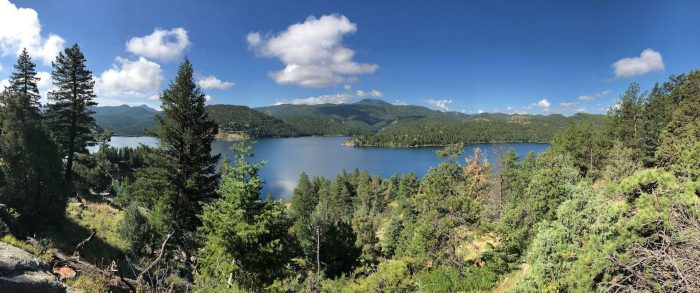In schools across America we encourage insightful thinking of our children by asking:
“Where does food come from?”
Often the answer is, “A can!” or “A box!” This, of course, leads to the real conversation about where food comes from. Another pressing question we all need to be asking ourselves is:
“Where does water come from?”
Is it the faucet, the hose, the grocery store soft drink aisle? The journey of water begins far before it hits our glass at the kitchen sink. Today, every one of us needs to be aware of, and concerned about, the growing water crisis in the world. It’s not just a matter of understanding where water comes from but, more importantly, who owns it and what are their motivations? And are their strategies and approaches in the best interests of the communities they purportedly serve?
Since the most recent drought cycle began in 2001 in the southwestern United States, including along the Front Range of Colorado, the conversation about population growth, water needs, demand, and the ability to supply water have been hot topics. The Colorado River Compact of 1922 governs the allocation of water from the Colorado River to the Upper Basin states (Colorado, Utah, Wyoming, and New Mexico) and the Lower Basin states (California, Arizona and Nevada). In the nearly 100 years since the Compact was signed, changes in our ways of life resulting in increased water use, combined with ongoing climate change, require that serious consideration be given as to how we will manage water in the future. One indication of the gravity of this situation is that in 2018, the seven states in the Compact agreed to a Drought Contingency Plan that spells out how cutbacks of water will be managed when shortages occur. Our challenges with developing sustainable water plans are just beginning.
Water from the Colorado River supplies roughly half of Denver’s annual water requirements and helps irrigate nearly two-thirds of the entire state’s irrigated agricultural lands. In 2019, Colorado is launching a far-reaching $20 million conservation planning effort to ensure the state can reduce water use enough to stave off a crisis in the drought-choked Colorado River Basin. Meanwhile, Denver Water, a public/private hybrid company serving the Denver metropolitan area, does not seem to be operating with this current reality in mind.
Even while the new Drought Contingency Plan and other agreements among the western states take form, Denver Water appears to have a short sighted end-game in play with the effort to divert more water from the Upper Colorado Basin to storage on the eastern slopes before the supply “disappears.”
Denver Water has many storage facilities along the Front Range. Gross Reservoir, located in the foothills above Boulder, Colorado, is one of Denver Water’s largest reservoirs with a capacity of 41,811 acre-feet of water. As one of the primary organizations controlling water distribution of Colorado’s allocation of Colorado River water, Denver Water determines where “their” water goes and how it is used. As part of their long term strategy, they have been working for nearly 20 years to move forward on a plan to raise Gross Dam 131 feet above its current 340 feet to enlarge its capacity by 77,000 acre-feet of water, most of which will come from the Colorado River Basin.
Denver Water’s arguments for this expansion are primarily based on 2002 forecasts of severe water shortages, with the preponderant focus on data collected from 1973-1999. This data does not include any analysis of the effects of climate change on water supplies, nor does it take into account the fact that Denver Water has made progress via its own efficiency programs to conserve water. In fact, water use in Denver Water’s service area has been decreasing even while their population is increasing. The CEO of Denver Water recently touted their success with regard to conservation in a press conference in which he highlighted the shift in usage.
In this graph (click through to drop down menu), generated by Denver Water[1], the trends are clear. People are using less water as the numbers living in the metropolitan area have gone up. This completely undercuts Denver Water’s “Purpose and Need” for expanding the reservoir.
[1]https://www.denverwater.org/your-water/water-supply-and-planning/water-use
And yet, Denver Water insists on bulldozing their way forward on the Gross Expansion project, the justification for which does not consider the new reality of the need for sustainable water management in the West. Reservoirs do not “make” water – there is no point in undertaking the largest and most expensive construction project of its kind in Boulder County history if there is no water to capture.
Local Concerns
Boulder County authorities and citizens have been raising red flags about this project for decades. The Environmental Impact Statement (EIS) prepared for the Army Corps of Engineers (USACE) for this project was deeply flawed and was vigorously analyzed and disputed by Boulder County. It does not even mention climate change or consider that the data being used to justify the project is decades old and doesn’t reflect current (and ongoing) drought conditions. It also does not address what the degradation to the land, environment, animal and human populations would be. Of particular concern, many of the “solutions” outlined in the EIS by Denver Water to address potential problems caused by the project are listed as “To Be Determined.”
From a NIMBY (Not In My Back Yard) point of view, the proposed project would provide no benefits to Boulder County, but would have substantial, negative impacts on the region and county including:
- Further draining the already seriously depleted Colorado River
- Destroying critical habitat for endangered Greenback cutthroat trout
- Raising mercury and other heavy metal levels in the reservoir
- Severely impacting wildlife in the Boulder County region around Gross
- Heavy traffic damaging roads in Boulder, Gilpin and Jefferson Counties
- Transporting toxic fly ash through Boulder County
- Removing at least 200,000 healthy trees
- Increased fire danger due to truck and helicopter traffic
- Threats to cyclists and motorists from 90+ truck trips per day on Hwy 72
- The list goes on and on…
Building a large dam to address water concerns also assumes that the water is there, or will be there, to divert. Water flows in the Colorado River have been diminishing over time. Colorado State and University of Arizona’s collaborative climate science studies[1]suggest that by the end of this century, flows contributing to the Colorado will be down 35-55%. Denver Water is assuming that there will be water in the Upper Colorado River Basin to divert, but the reality is, there is little evidence that if the dam is raised there will ever be sufficient water to fill it. In fact, there is no requirement that the reservoir be filled, even if the water WERE available. This leaves the very likely possibility that raising the dam will result in a giant, empty hole – a tree-denuded wasteland that is an edifice to a lack of science and foresight.
The real issue here, however, is not just NIMBY, or locally displaced or impacted residents, even though that facet is of tremendous interest to the local region and Boulder County. Instead, one must question why Denver Water is willing to fight local authorities to proceed with a controversial plan with costs of at least $464 million[2]?
The Real Story?
Trans mountain diversions will likely be limited as the new reality of our changing climate takes effect. The proposed expansion is NOT about serving Denver’s needs or the expanding population vis-a-vis usage. It is about the future use of water and working the old angle that “Possession is nine-tenths of the law.”
As a public agency, Denver Water is entirely funded through ratepayers, new tap fees and the sale of hydropower. Since they do not need additional water to supply the demands of their customers, they stand to make significant profit by selling available water. Agriculture is the largest consumer of water in Colorado. Denver Water could certainly market water they capture to those interests, as well as to other growing metropolitan areas such as Arvada, or for industrial uses such as fracking.
The New Reality
As discussed above, Denver Water’s own data shows that conservation efforts and increased awareness have diminished demand and water usage even while their population grows. So what if we made Denver THE MODEL for how water conservation and reuse can be done? There are estimates that 50% or more of the water from Gross Reservoir goes to water lawns, predominantly Kentucky bluegrass, during summers in Denver. Climate Central[3], an independent organization of scientists, predicts that if nothing is done to alter our current course, Denver’s climate will resemble that of southern Texas by 2100. Planting and watering lawns in a high-altitude desert, especially a non-indigenous variant with high-water requirements, makes NO sense.
The elephant in the room – agricultural use – is largely driven by inefficient and outmoded approaches that date back to the early days of irrigation. Watering top-down usually misses the roots of the plants and a large percentage of life-giving water evaporates. What if we took the $464 million dollars that Gross Expansion would require and invested that in sustainable water use plans and technology to increase irrigation efficiency?
If we re-evaluate the long-term efficacy of additional diversions and dam building, it is clear that building infrastructure and implementing policies to enable conservation and reuse are more sustainable paths forward than relying on old technology of damming and storing water. In recent years, the benefits of dams have come into question and some dams have been removed in both the US and overseas. A scientific analysis undertaken by the University of Uppsala, Sweden[4]recently cast doubt on whether such projects impact their stakeholders and regions in the ways that they were intended to.
The Right Conversation
The starting point of any dialogue about the water future of Colorado should be Conservation and Reuse. Our goal should be to use even less water and hold Denver’s per household usage to the highest standards in the country. Denver can become the model of water efficiency for the entire nation – setting the standard for the other states in the Colorado River Compact and Mexico.
The questions we should be asking then are:
- Do for-profit water managers like Denver Water need additional water to support their customers? If not, what other factors might be involved in their desire for access to additional water?
- Are dams, diversions, and retention projects appropriate technologies in view of the new reality of climate change? Will there be water available to capture, or do we need a new paradigm in managing water use?
- How can cities, towns, counties, and residents more effectively conserve and reuse water?
- How can the preponderant use of water – agricultural use for watering crops – be ameliorated through effective use of technology and innovation?
It’s time that we recognize that, like with all things that matter, water is an issue we take into our own hands. Our municipalities, our farmers, our politicians, and our public-private sector entities are thinking about it. The problem is that we have been having the wrong conversation, focusing on “getting more” and accessing supply rather than looking at our usage and developing long-term, sustainable plans for how we use a precious, limited resource.
To learn more, visit https://www.savebouldercounty.org/home
[1]https://source.colostate.edu/climate-change-shrinking-colorado-river/
[2]https://grossreservoir.org/faqs/
[3]https://www.climatecentral.org/news/summer-temperatures-co2-emissions-1001-cities-16583
[4]https://www.uu.se/en/news-media/press-releases/press-release/?id=4512&typ=pm







Read 0 comments and reply